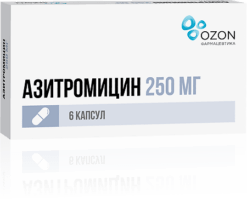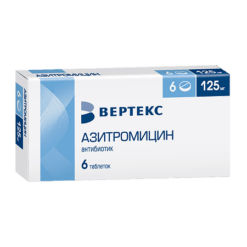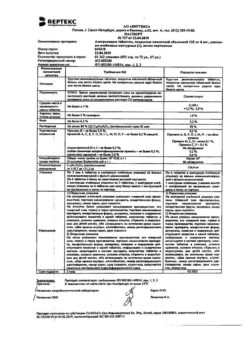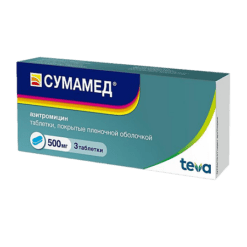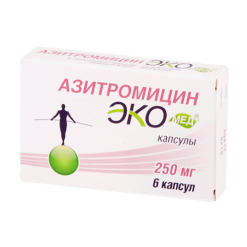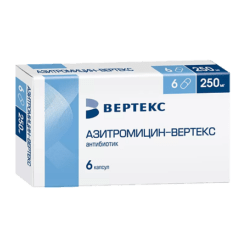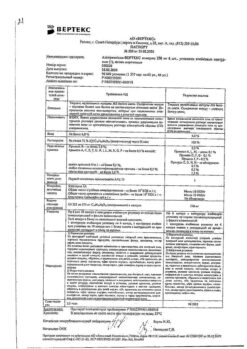No products in the cart.
Azithromycin, 500 mg capsules 3 pcs
€1.00
Out of stock
(E-mail when Stock is available)
Description
Pharmacodynamics
Azithromycin is a bacteriostatic broad-spectrum antibiotic of the macrolide-azalide group. It has a broad spectrum of antimicrobial action. The mechanism of action of azithromycin is associated with inhibition of microbial cell protein synthesis. Binding to 508-subunit of ribosomes, it inhibits peptide translocase at the translation stage and inhibits protein synthesis, slowing down the growth and reproduction of bacteria. In high concentrations it has bactericidal action.
It has activity against a number of Gram-positive, Gram-negative, anaerobes, intracellular and other microorganisms.
Microorganisms may be resistant to antibiotic action initially or may acquire resistance to it.
In most cases, sensitive microorganisms
- Gram-positive aerobes
Staphylococcus aureus – methicillin-sensitive, Streptococcus pneumoniae – penicillin-sensitive, Streptococcus pyogenes<. - Hamophilus influenzae, Haemophilus parainfluenzae, Legionella pneumophila, Moraxella catarrhalis, Pasteurella multocida, Neisseria gonorrhoeae
- Anaerobes
Clostridium perfringens, Fusobacterium spp., Prevotella spp, Porphyriomonas spp. - Other microorganisms
Chlamydia trachomatis, Chlamydia phneumoniae, Chlamydia psittaci, Mycoplasma pneumoniae, Mycoplasma hominis, Borrelia burgdorferi
Microorganisms that can develop resistance to azithromycin
Gram-positive aerobes
Streptococcus pneumoniae penicillin-resistant
Initially resistant microorganisms Gram-positive aerobes
Enterococcus faecalis, Staphylococci (methicillin-resistant staphylococci show a very high degree of resistance to macrolides).
Gram-positive bacteria that are resistant to erythromycin.
Anaerobes
Bacteroides fragilis
Pharmacokinetics
After oral administration azithromycin is well absorbed and rapidly distributed in the body. After a single use of 500 mg bioavailability is 37 % (effect of “first pass”), maximum concentration (0.4 mg/ml) in blood is achieved after 2-3 hours, apparent volume of distribution is 31.1 l/kg, protein binding is inversely proportional to blood concentration and is 7-50 %. It penetrates through cell membranes (effective in infections caused by intracellular pathogens). It is transported by phagocytes to the site of infection, where it is released in the presence of bacteria. Easily passes the histohematic barriers and enters the tissues. Concentration in tissues and cells is 10-50 times higher than in plasma, and in infection nidus it is 24-34% higher than in healthy tissues.
Azithromycin has a very long half-life – 35-50 hours. Tissue elimination half-life is much longer. The therapeutic concentration of azithromycin is maintained up to 5-7 days after the last dose. Azithromycin is mainly excreted unchanged – 50% by the intestine, 6% by the kidneys. In the liver it is demethylated, losing activity.
Indications
Indications
Infectious and inflammatory diseases caused by microorganisms sensitive to the drug:
Active ingredient
Active ingredient
Composition
Composition
1 capsule contains
active ingredient: azithromycin dihydrate (equivalent to anhydrous azithromycin) – 500 mg.
How to take, the dosage
How to take, the dosage
Internal, once a day, at least 1 hour or 2 hours after meals. Adults (including elderly people) and children over 12 years old with body weight over 45 kg.
Infections of upper and lower respiratory tract, ENT organs, skin and soft tissues – 0.5 g / day 1 course of 3 days (course dose – 1.5 g).
In erythema migrans (Lyme disease) stage 1 – once a day for 5 days: 1st day – 1.0 g, 2nd through 5th days – 0.5 g daily (course dose – 3 g).
Common acne – 6 g course dose, 0.5 g/day at 1 course for 3 days, then 0.5 g/day once a week for 9 weeks. The first weekly tablet should be taken 7 days after the first daily tablet (day 8 from the start of treatment), the next 8 weekly tablets – at 7-day intervals.
In urinary tract infections caused by Chlamidia trachomatis (uncomplicated urethritis or cervicitis) – once 1 g.
Administration to patients with renal impairment: for patients with moderate renal impairment (creatinine clearance > 40 ml/min) no dose adjustment is necessary.
Interaction
Interaction
Antacids do not affect bioavailability of azithromycin, but decrease maximum blood plasma concentration of azithromycin by 30%, therefore the drug should be taken at least one hour before or two hours after taking these drugs and meals.
Azithromycin does not affect blood concentrations of carbamazepine, didanosine, rifabutin and methylprednisolone when used together.
In parenteral use azithromycin has no effect on the blood concentrations of cimetidine, efavirenz, fluconazole, indinavir, midazolam, triazolam, trimethoprim/sulfamethoxazole when used together, but the possibility of such interactions should not be excluded when prescribing azithromycin for oral administration.
Azithromycin does not affect the pharmacokinetics of theophylline, but plasma concentrations of theophylline may be increased when co-administered with other macrolides.
If co-administration with cyclosporine is necessary, it is recommended to monitor blood levels of cyclosporine. Despite the fact that there are no data on the effect of azithromycin on changes in the blood concentration of cyclosporine, other representatives of the class of macrolides can change its blood plasma levels. When co-administration of digoxin and azithromycin, it is necessary to monitor blood levels of digoxin, since many macrolides increase digoxin absorption in the intestine, thereby increasing its concentration in plasma. If coadministration with warfarin is necessary, careful monitoring of prothrombin time is recommended.
The concomitant administration of terfenadine and macrolide class antibiotics has been found to cause arrhythmias and prolongation of the QT interval. Based on this, the above complications cannot be excluded when coadministering terfenadine and azithromycin.
Since there is a possibility of inhibition of CYP3A4 isoenzyme by parenteral azithromycin when co-administered with cyclosporine, terfenadine, ergot alkaloids, cisapride, pimozide, quinidine, astemizole and other drugs metabolized with this enzyme, the possibility of such interaction should be considered when administering azithromycin for oral administration.
When co-administering azithromycin and zidovudine, azithromycin has no effect on the pharmacokinetic parameters of zidovudine in blood plasma or on the renal excretion of it and its metabolite glucuronide. However, the concentration of the active metabolite, phosphorylated zidovudine, in the multinucleated cells of peripheral vessels is increased. The clinical significance of this fact is not clear.
The simultaneous administration of macrolides with ergotamine and dihydroergotamine may manifest their toxic effects (vasospasm, dysesthesia).
Special Instructions
Special Instructions
As with any antibiotic therapy, treatment with azithromycin may lead to superinfection (including fungal).
Azithromycin should be taken at least one hour before or two hours after taking antacids.
Effect on the ability to drive vehicles and mechanisms. During the treatment it is necessary to refrain from driving motor transport and engaging in potentially dangerous activities requiring high concentration and quick psychomotor reactions.
Contraindications
Contraindications
With caution
Moderate hepatic and renal dysfunction, in arrhythmias or predisposition to arrhythmias and QT interval prolongation, when terfenadine, warfarin, digoxin are co-administered.
Side effects
Side effects
Blood and lymphatic system disorders: thrombocytopenia, neutropenia.
Central nervous system disorders: dizziness/vertigo, headache, seizures, somnolence, paresthesia, asthenia, insomnia, hyperactivity, aggressiveness, anxiety, nervousness.
Senses: tinnitus, reversible hearing impairment to deafness (when taking high doses for a long time), impaired sense of taste and smell.
Cardiovascular system: palpitation, arrhythmia, ventricular tachycardia, QT interval increase, bidirectional ventricular tachycardia.
Gastrointestinal tract: nausea, vomiting, diarrhea, abdominal pain/spasms, flatulence, indigestion, anorexia, constipation, discolored tongue, pseudomembranous colitis, cholestatic jaundice, hepatitis, changes in laboratory parameters of liver function, liver failure, liver necrosis (possibly fatal).
Allergic reactions: itching, skin rash, angioneurotic edema, urticaria, photosensitization, anaphylactic reaction, including edema (rarely fatal), erythema multiforme, Stevens-Johnson syndrome, toxic epidermal necrolysis. Musculoskeletal system: arthralgia.
Urinary system: nephritis, acute renal failure.
Other: vaginitis, candidiasis.
Overdose
Overdose
Symptoms: nausea, temporary hearing loss, vomiting, diarrhea.
Treatment: administration of activated charcoal, gastric lavage, symptomatic therapy.
Pregnancy use
Pregnancy use
In pregnancy the drug is prescribed only when the expected benefit to the mother is greater than the potential risk to the fetus.
If it is necessary to use the drug during lactation, the question of stopping breastfeeding for the duration of the drug should be decided.
Similarities
Similarities
Additional information
| Shelf life | 3 years. |
|---|---|
| Conditions of storage | In a dry, light-protected place at a temperature not exceeding 25 ° C. |
| Manufacturer | Manufacturing of medicines, Russia |
| Medication form | capsules |
| Brand | Manufacturing of medicines |
Other forms…
Related products
Buy Azithromycin, 500 mg capsules 3 pcs with delivery to USA, UK, Europe and over 120 other countries.


